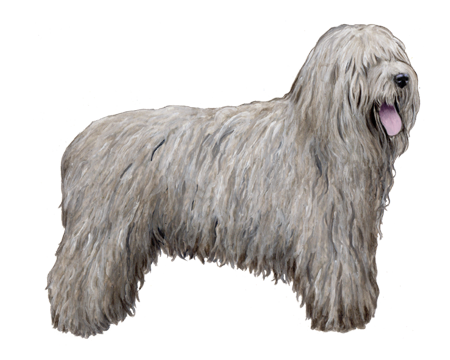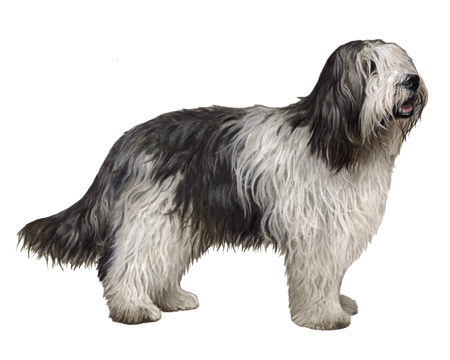
Bergamasco
The Bergamasco proves that looks can be deceiving. The tangle-haired breed is not just an adorable companion; these independent dogs are vigilant guard dogs with strong protective instincts.
Interested in discovering if your dog is a Bergamasco?
Check out Wisdom Panel's DNA tests.

Bergamasco Traits
General Appearance
The Bergamasco is a compact herding dog. Beneath their flocks of hair, the Bergamasco is a muscular and heavy-boned breed with calm, balanced movements.
Coat and Coloring
The Bergamasco has three different kinds of hair: Their undercoats are short, dense, and fine; it feels oily to the touch and forms a waterproof layer against the skin. Their outercoats and a layer known as “goat hair” are not distributed evenly over their bodies, creating the characteristic strands of woven hair that fall in flat, felted layers—called flocks—that give the Bergamasco its unique appearance. The goat hair is long, straight, and has a rough texture while the outer coat is woolly and finer in texture.
The flocks range from one-and-a-half to three inches wide; they are flat, irregular in shape, larger at the base than the ends, and can open in a fan shape. Flocks are never combed out. The Bergamasco has more goat hair on its head and from the withers to the midpoint of its body, while the outer coat is more abundant on the back of the body and the legs.
The Bergamasco is solid gray in color; gradations of gray, including merle (up to and including solid black) and shadings of Isabella and fawn on the lower part of the flocks are also allowed in show. The breed standard does not allow standard white, but white markings are acceptable provided they do not cover more than 20% of the body.
Distinctive Physical Traits
The Bergamasco is a large dog with massive, strong shoulders; muscular thighs; and strong, arched necks. These dogs have large, oval, brown eyes, and soft, thin ears that hang down on either side of their faces.
Bergamasco Temperament
Although Bergamascos have a distinct look that attracts a lot of attention, these dogs might not want strangers in its space. The Bergamasco is a vigilant guard dog with a strong protective instinct. While the breed is not known for being aggressive without cause, it can be standoffish with strangers. The Bergamasco is also patient, quiet, eager to please, and affectionate, making it a good companion for those in its trusted circle.
The Bergamasco is used to patrolling wide open spaces and still prefers room to roam. It will do best in a home with a large, fenced yard and is not well-suited to apartment living.


Bergamasco History
In pre-Roman times, the Phoenicians often bartered sheepdogs around the Mediterranean basin, allowing the ancestors of the Bergamasco Sheepdog to spread throughout Europe and the Middle East.
The breed became known as the Bergamasco Sheepdog because of the breed's association with the Italian town of Bergamo. There is some debate about the origins of the alpine breed: Some believe that the Bergamasco descended from an ancient Gaelic herding dog called the Briard while others insist that the Bergamasco came first and led to the development of the Briard. It is agreed that both sheepdog breeds excelled in their roles guarding and moving sheep on the rugged terrain in the Italian Alps.
The Bergamasco’s numbers started declining after World War II but renewed interest in the breed—and the 2015 addition of the Bergamasco to the American Kennel Club stud book—could help the working dog become more popular.
Bergamasco Care
Nutrition
Feed Bergamascos a high-quality dog food that is appropriate for their life stage (puppy, adult, senior) and consider a diet formulated for active breeds. Portion out their food with a standard measuring cup and limit treats to no more than 10% of their daily calories to avoid overfeeding and prevent weight gain.
Grooming
Despite their well-coiffed appearance, the Bergamasco has a maintenance-free coat once the flocks are established. Puppies do not have goat or wool hair on their outer coats; it comes in when the dogs are around one year old. When it appears, the coat must be “ripped” into flocks, which can take a few hours but it needs no further maintenance after that.
Bergamascos are a non-shedding breed and their hair requires no brushing; these dogs rarely even need baths! The thick coats help Bergamascos regulate their temperatures and should never be shaved.
Trim their nails to prevent cracking, splitting, and painful overgrowths, and clean their ears. Regular dental care that includes at-home teeth brushing and professional cleanings is also an essential part of their grooming routines.
Exercise
Bergamascos are a moderately active breed that enjoys going for walks playing in a fenced yard, especially when it means spending quality time with their owners. They may also enjoy dog sports such as agility, herding, flyball, and competitive obedience. Provide opportunities for mental and physical stimulation such as games and puzzle toys to keep this intelligent breed engaged and active.
Training
Bergamascos are intelligent and eager to please, a combination that makes them easy to train. A consistent training program that incorporates positive reinforcement and rewards can allow them to become well-mannered adults. The social, intelligent breed also requires regular socialization to help them feel comfortable with strangers and could also temper their protective instincts.

Breed Group
Herding
The herding group is a diverse category. These highly intelligent breeds were developed to guard and control the movement of livestock.
Resources
https://www.akc.org/dog-breeds/bergamasco-sheepdog/
Reviewed July 26, 2020 by Cindy Elston, DVM, MPH























































